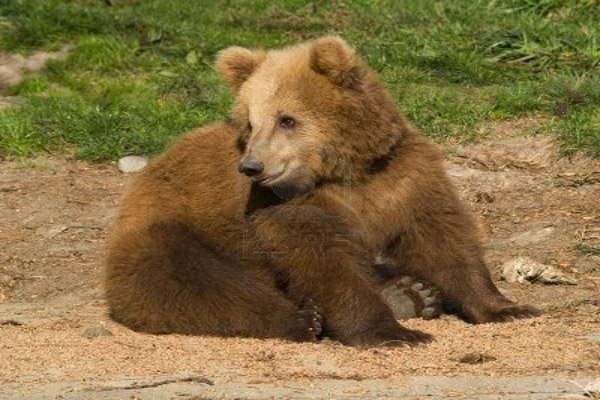TIBETAN BROWN BEAR
Ursus arctos pruinosus
Physical Description
The Tibetan Brown Bear is a subspecies of the Brown Bear. The Tibetan Brown Bear has shaggy, dark brown to black fur, with a cream to cinnamon face, and a white collar that broadens from the shoulders to the chest. The Tibetan Brown Bear’s small ears are covered with long black fur. The Brown Bear’s sense of smell is much more acute than its hearing and sight.
The Brown Bear has a concave outline to its massive head and snout, and high shoulders that produce a sloping back line. The claws of a Brown bear can reach almost 12.7 centimetres (five inches) in length.
The Tibetan Brown Bear is a medium-sized bear. The combined length of the Brown Bear’s head and body is 172 to 284 centimetres (68 to 112 inches). The Bear’s tail length ranges from just six to 22 centimetres (2.5 to 8.5 inches). The Brown Bear weighs about 95 to 780 kilograms (209 to 1,720 pounds). Adult male bears are typically heavier than adult females.
Habitat
The Tibetan Brown Bear inhabits alpine forests, meadows, and steppe, at elevations from 2,000 to 4,500 metres (6,560 to 14,760 feet). The Brown Bear has the widest habitat range of any bear species in the world.
The Bear’s range includes: northwest North America; orthern Europe, from Scandinavia to eastern Russia; the central European mountains; and parts of West and Central Asia, from Syria, across the Central Asian Republics, to the Tibetan Plateau. The Tibetan Brown Bear, however, is found only on the Tibetan Plateau.
Eating Habits
The omnivorous Brown Bear can eat up to 11 to 16 kilograms (25 to 35 pounds) of food per day, or roughly two percent of its body weight.
The bulk of the Tibetan Brown Bear’s diet consists of pikas, green and dry grass, and roots. The Tibetan Brown Bear also eats ungulates (probably scavenged) like blue sheep, argali, chiru, and yaks, as well as marmots, tubers, herbs, and insects. The Tibetan Brown Bear occasionally attacks livestock.
Behaviour and Reproduction
The Brown Bear is a solitary animal, except for mothers accompanied by their cubs. However, Brown bears will congregate where food is abundant, such as at salmon streams or garbage dumps. The Tibetan Brown Bear probably hibernates from October to April. The Brown Bear breeds in May or June. Bear mothers give birth in January or February, each to as many as four cubs. Cubs are helpless at birth and weigh about 364 grams (13 ounces). Cubs stay with their mothers for about four years after their birth. Mothers generally do not give birth to another litter until the spring after they have separated from their cubs.
The life span of the Brown Bear ranges from 20 to 30 years, for bears in the wild. Brown bears in zoos live for somewhat longer. The Brown Bear can run at speeds up to 50 kilometres (30 miles) per hour.
Present Status
The Tibetan Brown Bear is listed under Appendix I of CITES and the U.S. Fish and Wildlife Service has designated the Tibetan Brown Bear endangered. The Tibetan Brown Bear is under second class protection in China. Brown bears are included in Schedule II, Part I of the Indian (Wildlife) Protection Act of 1972.
Threats to Survival
The Brown Bear population has dropped to less than two percent of its original size. This dramatic decrease in numbers can be partially attributed to habitat loss. The most serious threat to the Brown Bear’s survival, however, is that posed by increased poaching of the Bear. The Brown Bear is poached to obtain the Bear’s body parts, including its gall bladder, for use in traditional Asian medicines. Furthermore, Tibetan nomads often kill the Tibetan Brown Bear because the Bear is dangerous, may prey upon livestock, and may be considered a manifestation of an evil spirit. Because the Brown Bear has a low birth rate and its cubs have a high death rate (up to 50 per cent mortality), it is especially difficult for the Bear population to recover its losses.
References
Schaller, George B., 1998: Wildlife of the Tibetan Steppe, The University of Chicago Press, London, 80pp.
Wang, Youzhi, and Hu, Jinchu, 1999: Color Pictorial Handbook of the Mammals of Sichuan, Chinese Forestry Publication Press, 278pp.
By: Environment and Development Desk, DIIR, CTA.



[…] https://tibetnature.net/en/tibetan-brown-bear/ […]